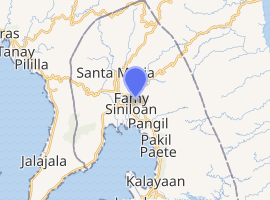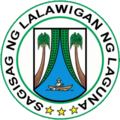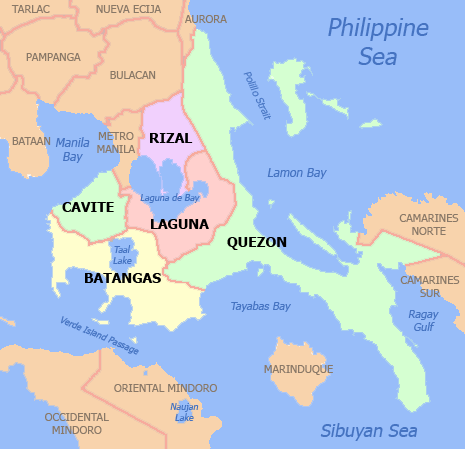Famy, Laguna
Famy, officially the Municipality of Famy, (Tagalog: Bayan ng Famy), is a 5th class municipality in the province of Laguna, Philippines. According to the 2015 census, it has a population of 16,587 people.[4]
Famy | |
|---|---|
| Municipality of Famy | |
Downtown area | |
 Seal | |
| Nickname(s): Home of Bamboo Weavers | |
| Motto(s): Bang Gara Aba! | |
 Map of Laguna with Famy highlighted | |

| |
.svg.png) Famy Location within the Philippines | |
| Coordinates: 14°26′N 121°27′E | |
| Country | |
| Region | Calabarzon (Region IV-A) |
| Province | Laguna |
| District | 4th District |
| Founded | August 15, 1910 [1] |
| Barangays | 20 (see Barangays) |
| Government | |
| • Type | Sangguniang Bayan |
| • Mayor | Edwin V. Pangilinan |
| • Vice Mayor | Gertrudes S. Andaya |
| • Congressman | Benjamin C. Agarao Jr. |
| • Electorate | 12,620 voters (2019) |
| Area | |
| • Total | 53.06 km2 (20.49 sq mi) |
| Elevation | 8.6 m (28.2 ft) |
| Population (2015 census)[4] | |
| • Total | 16,587 |
| • Density | 310/km2 (810/sq mi) |
| • Households | 3,611 |
| Economy | |
| • Income class | 5th municipal income class |
| • Poverty incidence | 10.18% (2015)[5] |
| • Revenue (₱) | 54,877,259.48 (2016) |
| Time zone | UTC+8 (PST) |
| ZIP code | 4021 |
| PSGC | |
| IDD : area code | +63 (0)49 |
| Climate type | tropical monsoon climate |
| Native languages | Tagalog |
| Website | www |
Famy lies in the north-eastern part of the province of Laguna via Manila East Road. It has a total land area of 3.297 square miles (8.54 km2) which is bounded by the town of Real, Quezon, in the east, in the north by Santa Maria, in the west by Mabitac and Santa Maria, and in the south by Siniloan and Mabitac.
History
Famy started as a barrio of Siniloan as Calumpang until August 15, 1910. The town takes its name from the surname of President Emilio Aguinaldo's mother, Trinidad.
Barangays
Climate
| Climate data for Famy, Laguna | |||||||||||||
|---|---|---|---|---|---|---|---|---|---|---|---|---|---|
| Month | Jan | Feb | Mar | Apr | May | Jun | Jul | Aug | Sep | Oct | Nov | Dec | Year |
| Average high °C (°F) | 26 (79) |
27 (81) |
29 (84) |
31 (88) |
31 (88) |
30 (86) |
29 (84) |
29 (84) |
29 (84) |
29 (84) |
28 (82) |
26 (79) |
29 (84) |
| Average low °C (°F) | 22 (72) |
22 (72) |
22 (72) |
23 (73) |
24 (75) |
25 (77) |
24 (75) |
24 (75) |
24 (75) |
24 (75) |
24 (75) |
23 (73) |
23 (74) |
| Average precipitation mm (inches) | 58 (2.3) |
41 (1.6) |
32 (1.3) |
29 (1.1) |
91 (3.6) |
143 (5.6) |
181 (7.1) |
162 (6.4) |
172 (6.8) |
164 (6.5) |
113 (4.4) |
121 (4.8) |
1,307 (51.5) |
| Average rainy days | 13.4 | 9.3 | 9.1 | 9.8 | 19.1 | 22.9 | 26.6 | 24.9 | 25.0 | 21.4 | 16.5 | 16.5 | 214.5 |
| Source: Meteoblue [7] | |||||||||||||
Demographics
| Population census of Famy | ||
|---|---|---|
| Year | Pop. | ±% p.a. |
| 1903 | 1,262 | — |
| 1918 | 1,095 | −0.94% |
| 1939 | 1,547 | +1.66% |
| 1948 | 1,569 | +0.16% |
| 1960 | 4,163 | +8.47% |
| 1970 | 4,651 | +1.11% |
| 1975 | 5,222 | +2.35% |
| 1980 | 5,241 | +0.07% |
| 1990 | 7,928 | +4.23% |
| 1995 | 9,661 | +3.77% |
| 2000 | 10,419 | +1.63% |
| 2007 | 13,577 | +3.72% |
| 2010 | 15,021 | +3.75% |
| 2015 | 16,587 | +1.91% |
| Source: Philippine Statistics Authority[4][8][9][10] | ||
In the 2015 census, the population of Famy, Laguna, was 16,587 people,[4] with a density of 310 inhabitants per square kilometre or 800 inhabitants per square mile.
References
- https://m.facebook.com/story.php?story_fbid=1512182618807250&id=100000465783169
- "Municipality". Quezon City, Philippines: Department of the Interior and Local Government. Retrieved 31 May 2013.
- "Province: Laguna". PSGC Interactive. Quezon City, Philippines: Philippine Statistics Authority. Retrieved 12 November 2016.
- Census of Population (2015). "Region IV-A (Calabarzon)". Total Population by Province, City, Municipality and Barangay. PSA. Retrieved 20 June 2016.
- "PSA releases the 2015 Municipal and City Level Poverty Estimates". Quezon City, Philippines. Retrieved 1 January 2020.
- Philippine Standard Geographic Code listing for Famy - National Statistical Coordination Board
- "Famy: Average Temperatures and Rainfall". Meteoblue. Retrieved 11 May 2020.
- Census of Population and Housing (2010). "Region IV-A (Calabarzon)". Total Population by Province, City, Municipality and Barangay. NSO. Retrieved 29 June 2016.
- Censuses of Population (1903–2007). "Region IV-A (Calabarzon)". Table 1. Population Enumerated in Various Censuses by Province/Highly Urbanized City: 1903 to 2007. NSO.
- "Province of Laguna". Municipality Population Data. Local Water Utilities Administration Research Division. Retrieved 17 December 2016.
External links
| Wikimedia Commons has media related to Famy, Laguna. |

